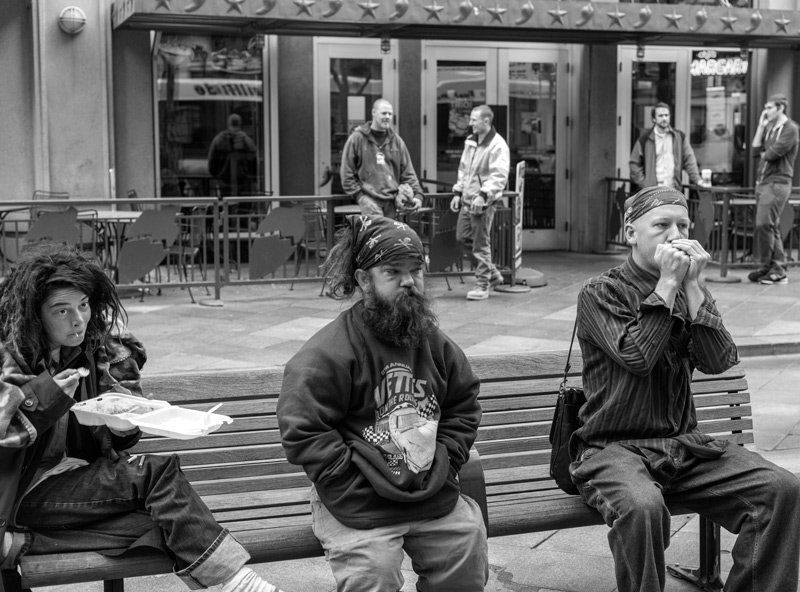The often-overlooked importance of photography.
Three reasons why photographs can add to our lives.
The photographs we take (with a camera or these days on a phone) offer a significance to our lives that many may not realize. Recently, I was reminded of this when viewing old photos by Builder Levy, a noted teacher and photographer; visiting the Missouri History Museum to take in their Panoramas of the City exhibit, and my daily run through Instagram, Facebook and periodicals like Communications Arts that zero in on outstanding and surprising photography.
It occurred to me, once again, that first and foremost, looking at older photos – especially from “film” days and prior – that there is a very real historical value to photographs. Time distorts our memory for some reason. Long times where recollections are reinforced by oral history can be distorted beyond recognition when set next to the facts. We look upon so much of the past as the good old days until we are reminded that things weren’t as rosy and wonderful through photos from that era. I guess that’s why times before photography when captured by artists painting on canvass are often subjected to greater scrutiny, given the artist’s license to embellish, exaggerate, or take a detour from fact.
So the historical perspective of photography – professional, amateur, casual or formal – is very important and valuable to all of us. But, there are two dividends of today’s photography that may be as important. Especially in the photojournalism we are provided by brave and intentional photographer’s investigation of events, whether they are everyday or spectacular news items such as war, natural catastrophes, or historic breakthroughs.
I remember the first occurrences of great photojournalism in my lifetime – the Abraham Zapruder film footage of John Kennedy’s assassination, the coverage of Viet Nam by Larry Burrows, Catherine Leroy, Henri Huet and many others, and the coverage of the September 11, 2001 terrorism attacks. These men and women often take extraordinary risks to bring the real nature of news events back to us, who often lead placid everyday lives sheltered away from any turmoil. Their images have awakened the conscience of our society to stem wars, start wars, change attitudes, and forewarn us of tyranny.
The old adage, a picture is worth a thousand words, comes to mind too quicklly. A photo can quickly expose injustice, anger, fear, suffering, or inequality when explaining those conditions may take many words and not be as convincing in the end. Words become opinions too easily discounted; images are often more convincing because what you see “just outside your window” is often more believable having been an eyewitness.
Witnessing life through the images you yourself take or are captured by others can become a personal road map to how you look at life, react to current events and thinking, and interact with the rest of society. Seeing a lot of homeless people everyday, for example, can stir reactions from the extremes of great compassion and desire to help alleviate their situation, or to the other extreme, to retract from seeing the homeless as victims so it is easy to avoid them and look the other way, blame and criminalize them, and even despise them. It’s your choice, a choice demanded by your individual reaction to a visual image you’ve experienced either in person or through a photograph in your life’s experience. Henry David Thoreau said it best, “It is not what you look at that matters, it is what you see.”
With some images, we can also unveil some truths about ourselves, some things that we may not have been aware of or acknowledged before. Have you ever seen a photo that appealed to you in some surprising way? The colors, the contrast, an expression on a face, a place you’ve never been to but suddenly want to visit? These attractions can be surprising and can tell you, or reaffirm, something about yourself. For me, it is seeing people in ways I wouldn’t imagine them as being before. Through my own photography I have discovered that beauty exists in ways and places I would never have assumed or even looked for otherwise.
“I lived a relatively tame and self-contained life,” renowned street photographer Builder Levy once said. “But, with photography I was able to live a more intense and fulfilling life. Through my photography I am trying to change the consciousness of the world. I believe real change comes from the bottom up.”
I guess that’s why art museums are so important to the growth and viability of society. They opens not only eyes, but minds too. That is precisely what attracts me to new, local exhibitions – especially photo exhibits. And, that is why I miss those great photo spreads of yesteryear that flourished on newsstands via Life, Look, National Geographic, and others.
Today, there are websites and we should not overlook them if you want greater exposure to photojournalism and fine art photography. Here are a few of my favorites if you want to take in some great images and see how they impact your mind:
LFI – https://lfi-online.de/ceemes/
Lens Culture – https://www.lensculture.com
Lens , New York Times – https://www.nytimes.com/section/lens
Adore Noir (site and hard copy magazine) – https://www.monochromamagazine.com
Communications Arts * (CA) (online and hard copy magazine) – https://www.commarts.com
* Note: this publication explores many media and genres of creativity in the fine art and commercial art industries. Great reads even if you are not a practitioner.
The benefit to exposing (no pun intended) yourself to new visual images – and actually getting immersed in making/capturing your own images – can open your life to a new world of colors, sensations, knowledge, and appreciation. You may already do some of this unconsciously. But, if not, try it. Let me know if you decided to expand your self-awareness in this way and tell me what you discovered.
#imageisking #photographyisworththousandwords #photojournalismspeedsupcommunication #rawemotionsintheimage
